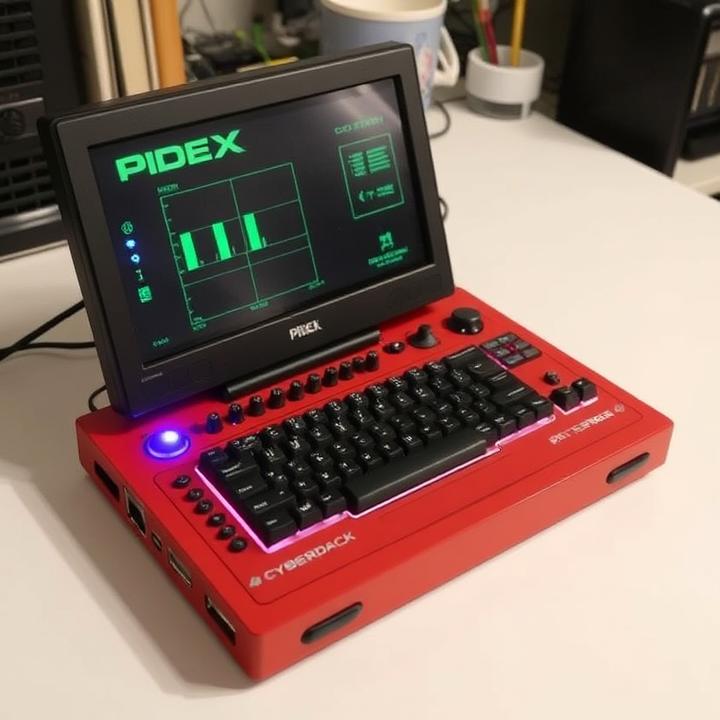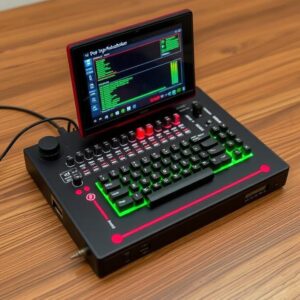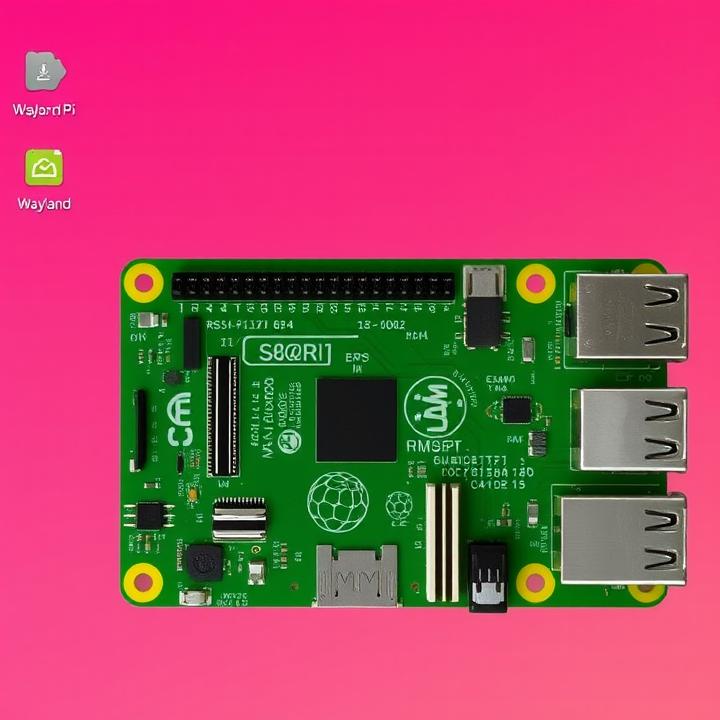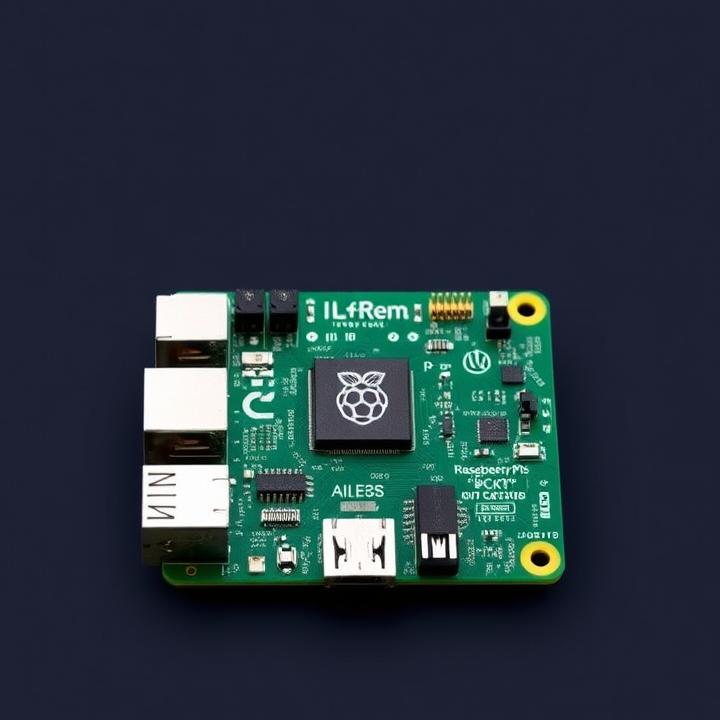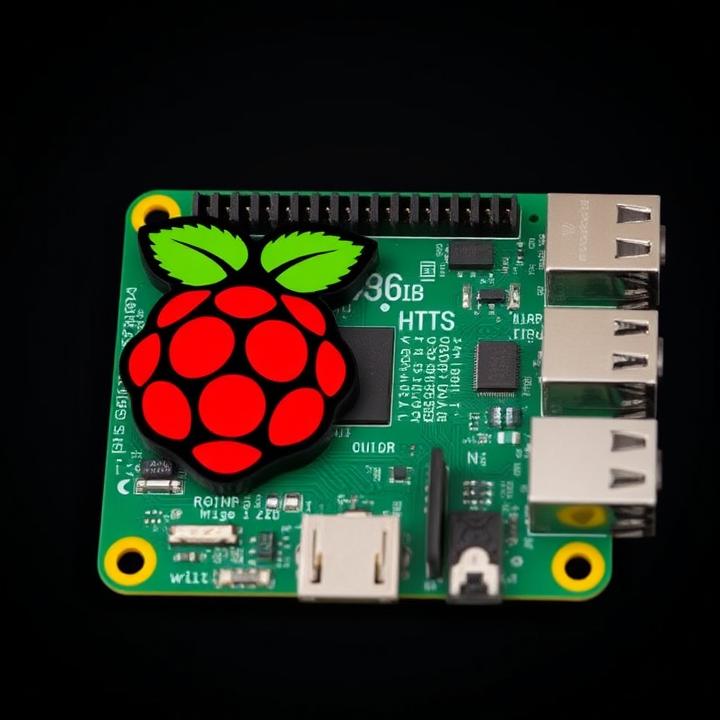PiDex is a groundbreaking cyberdeck powered by the Raspberry Pi 5, designed to deliver portable, rugged, and versatile computing for a variety of real-world applications. Whether you’re into ethical hacking, off-the-grid fieldwork, or IoT development, PiDex provides the power, flexibility, and portability you need to succeed. This article explores the capabilities of PiDex and its role in the growing ecosystem of DIY Raspberry Pi projects.
PiDex: The Raspberry Pi 5-Powered Cyberdeck
PiDex is a revolutionary concept in portable computing, designed for users who need power, durability, and mobility. The cyberdeck combines the Raspberry Pi 5, a small yet powerful computing board, with a rugged, customizable case that includes a 10.1-inch touchscreen display. Unlike conventional laptops or tablets, PiDex offers a modular approach to portable computing, enabling users to modify and adapt the system to their specific needs. This section outlines the concept of a cyberdeck, why PiDex is unique, and how it harnesses the power of the Raspberry Pi 5 to bring a new level of computing mobility.
PiDex represents the next evolution of portable computing for the modern, tech-savvy user. With its compact form factor and powerful ARM Cortex-A76 processor, it competes with traditional laptops for specific use cases, such as fieldwork, hacking, and IoT prototyping. The PiDex is ruggedly designed to handle outdoor environments, dust, and moisture, making it a versatile tool for those working in harsh conditions. With ample connectivity options like USB 3.0, Gigabit Ethernet, HDMI, and Wi-Fi, users can integrate PiDex with a wide variety of peripherals and devices, such as sensors, cameras, and external storage.
Key Features:
- ARM Cortex-A76 Processor: The Raspberry Pi 5’s 1.5 GHz CPU delivers significant performance improvements, enabling PiDex to run applications that require more power, such as security tools, software development environments, and data analysis programs.
- Touchscreen Display: The 10.1-inch display provides a large workspace for users to run applications, code, or interact with IoT devices. The screen’s touchscreen capability enhances usability, especially in environments where a mouse and keyboard may not be ideal.
- Rugged Case: The military-grade plastic shell ensures that PiDex can withstand tough outdoor conditions, offering protection against drops, shocks, and exposure to the elements.
- Solar Charging: A solar-powered option allows users to recharge PiDex in remote locations, ensuring that it remains operational in off-the-grid environments.
Features of the PiDex Cyberdeck
PiDex isn’t just a typical Raspberry Pi project—it’s an integrated computing solution designed for a range of applications that require both portability and durability. Let’s break down its key features in greater detail:
- Portable and Lightweight: PiDex’s compact form factor and rugged construction make it an ideal portable computing solution. Weighing just under 2kg, PiDex is designed to be carried on adventures, to fieldwork, or into environments where traditional laptops would be too bulky or fragile. Whether you’re going hiking, exploring a remote area, or attending a hacker convention, PiDex can easily fit into your bag or carry case.
- Powerful Performance: The Raspberry Pi 5’s ARM Cortex-A76 processor provides significant computational power compared to its predecessors. It is capable of handling tasks that require processing power, such as running security software, developing code, or performing network analysis. With 8GB of RAM, PiDex can multitask effectively and run more resource-intensive applications that many previous Raspberry Pi models struggled with.
- Connectivity Options: PiDex boasts a wide array of connectivity options, including Gigabit Ethernet for fast network access, multiple USB 3.0 ports for peripherals, and HDMI output for attaching external displays. This makes it incredibly versatile for tasks ranging from software development to field testing of IoT systems. Additionally, PiDex has built-in Wi-Fi and Bluetooth 5.0, allowing it to seamlessly connect with a variety of wireless devices such as sensors, security cameras, and smart home components.
- Customizable Interface: The PiDex’s 10.1-inch touchscreen is designed for easy interaction, whether you’re coding, browsing, or configuring IoT setups. It offers flexibility to create a more tailored experience by adding peripherals such as a mouse, keyboard, or even additional monitors. The modular nature of the design means users can easily upgrade or replace components based on their needs, making PiDex an adaptable solution for a wide range of users.
- Durability and Rugged Design: As mentioned earlier, the case is constructed from military-grade plastic, making PiDex resistant to impacts, dust, and moisture. Whether you’re working in a harsh outdoor setting or need something that can endure the wear and tear of constant travel, PiDex offers durability where traditional laptops may fail.
- Extended Battery and Solar Charging: PiDex is equipped with a rechargeable lithium-ion battery that ensures several hours of continuous use, depending on the workload. Additionally, users can opt for a solar-powered charging solution that provides power in environments where electricity may be scarce or unavailable. With this functionality, PiDex can continue to operate even in off-the-grid locations for extended periods.
Building Your Own PiDex Cyberdeck
For DIY enthusiasts and those looking to customize their portable computing setup, building a PiDex cyberdeck is a rewarding project. Here’s how to get started:
- Gather Components: First, you’ll need a Raspberry Pi 5 board, a 10.1-inch touchscreen display, a power management system, and a rugged case. You’ll also need a USB keyboard and mouse, optional peripherals like a camera or sensors, and a solar charging solution. You can find many of these components online or at specialized electronics stores.
- Assemble the Hardware: Start by securely mounting the Raspberry Pi 5 to the case. Ensure all necessary components, such as the display and USB ports, are properly connected. Follow any instructions for connecting the touchscreen, battery pack, and additional peripherals. Pay attention to cable management to avoid clutter and ensure easy access to ports.
- Install the Operating System: Once the hardware assembly is complete, you can install the Raspberry Pi OS or another Linux-based distribution. Raspbian (now Raspberry Pi OS) is the default and works well for most PiDex use cases, but you may want to install specialized software for ethical hacking, IoT development, or fieldwork. For hacking and security testing, Kali Linux is a good choice.
- Configure the Device: After installing the OS, configure the settings, such as Wi-Fi connections, screen brightness, power options, and customizations to make PiDex work for your specific needs. If you’re adding extra peripherals like a camera, GPS, or sensors, make sure they’re recognized by the OS and properly configured.
PiDex in Real-World Applications
PiDex is more than just a tech enthusiast’s toy—it’s a functional tool with broad applications in various fields, including security testing, research, and IoT development. This section will highlight some of the most exciting real-world applications:
- Ethical Hacking and Security Testing: PiDex is an excellent choice for ethical hackers who need a portable, powerful tool for penetration testing and security assessments. The Raspberry Pi 5’s robust hardware and compatibility with tools like Kali Linux make it a great choice for conducting security audits and vulnerability assessments in the field. PiDex’s compact size and rugged case allow it to fit in a backpack, making it easy to bring along for on-site penetration testing.
- Field Research and Exploration: For environmental researchers, PiDex offers a powerful tool for data collection, processing, and analysis while on the go. Whether tracking wildlife, measuring atmospheric conditions, or conducting geological surveys, PiDex can handle data logging and real-time analysis. Its extended battery life and solar charging options mean that researchers can rely on PiDex for days at a time without worrying about access to power.
- IoT Development: PiDex can be used as a development platform for building and testing IoT devices. Developers can use the GPIO pins on the Raspberry Pi 5 to interface with sensors, cameras, and other peripherals, creating IoT systems that can monitor environments, control devices, or collect data. PiDex’s portability allows developers to deploy and test their IoT solutions anywhere, whether it’s in a lab or on a field trip.
Advantages of PiDex Over Traditional Laptops
While traditional laptops have their place, PiDex offers several distinct advantages in specific use cases. Here’s why PiDex is a superior choice for certain applications:
- Affordability: PiDex provides an affordable alternative to traditional laptops. With its base price being significantly lower than most high-end laptops, PiDex makes it accessible to a broader audience, including students, hobbyists, and professionals on a budget.
- Customization and Expandability: Unlike most laptops, PiDex can be easily modified. Users can add custom hardware components, such as sensors, external storage, and cameras, or upgrade existing components like the battery or display. This makes PiDex far more adaptable than conventional laptops, which are typically limited in terms of upgradeability.
- Field-Ready Design: While laptops are generally designed for use in controlled environments, PiDex is built for rugged conditions. Its durable case can withstand drops, moisture, and dirt, making it the perfect companion for fieldwork, off-the-grid computing, or working in harsh environments.
- Power Independence: Unlike laptops, which require access to a power outlet for extended use, PiDex offers users the ability to recharge in remote locations using solar power. This makes it a game### 6. The Future of PiDex: Expanding the Cyberdeck Ecosystem
PiDex, powered by the Raspberry Pi 5, represents just the beginning of a new era in portable computing. As Raspberry Pi continues to evolve, PiDex can be expanded with new functionalities and capabilities. Here are some possible future developments:
- Enhanced Hardware: As the Raspberry Pi platform evolves, future iterations of PiDex will likely incorporate the latest advancements in computing power. With faster processors, more RAM, and enhanced connectivity options, the next generation of PiDex cyberdecks could become even more capable of handling demanding tasks in real time.
- Modular Components: One exciting development could be the introduction of modular components, such as swappable screens, additional sensor kits, or specialized power management systems. This would allow users to tailor their PiDex setups for specific tasks, whether they are focused on security research, environmental monitoring, or IoT development.
- Improved Battery Life and Charging Options: Battery technology is advancing rapidly, and PiDex could benefit from the development of longer-lasting batteries that allow for even greater autonomy in the field. Additionally, the inclusion of wireless charging or more efficient solar panels could make PiDex even more versatile for off-the-grid users.
- Software Advancements: As more specialized applications for cybersecurity, IoT, and field research emerge, PiDex could become a go-to platform for deploying and running such applications. The continuous development of Raspberry Pi-compatible operating systems, such as Raspberry Pi OS and Ubuntu, will ensure that PiDex remains a powerful tool for developers and hackers alike.
- Community Contributions: The open-source nature of the Raspberry Pi community means that PiDex could receive continuous improvements from developers worldwide. New software, accessories, and expansion boards will allow PiDex to evolve in unexpected ways, fostering innovation and pushing the boundaries of what a portable, Raspberry Pi-powered cyberdeck can do.
PiDex Cyberdeck in the Context of DIY Projects
For hobbyists and DIY enthusiasts, PiDex represents an exciting new frontier in building customized portable computing systems. DIY cyberdeck projects have been popular for years, but PiDex takes the concept to the next level by offering a fully integrated, powerful system that can be used in a wide variety of projects.
- Beginner-Friendly Yet Customizable: PiDex offers an ideal starting point for those new to building cyberdecks. The Raspberry Pi 5 is an accessible platform, and PiDex’s pre-configured system provides users with everything they need to begin working with it right away. At the same time, it’s highly customizable, allowing more experienced builders to make modifications and improvements as they gain experience.
- PiDex for Educational Use: Schools, universities, and coding boot camps can use PiDex as a hands-on learning tool. It provides an affordable way for students to engage in programming, cybersecurity, and hardware projects. Teachers can design exercises around PiDex’s modularity and portability, helping students understand the fundamentals of computing and hardware engineering in a fun, interactive way.
- Unique Use Cases for Makers and Tinkerers: DIY makers can also take advantage of PiDex for a variety of custom-built projects. Whether it’s building a portable weather station, a remote monitoring system, or a handheld device for controlling home automation systems, PiDex offers the flexibility to bring a wide range of ideas to life. The PiDex ecosystem is supported by a large community of makers who share projects, tutorials, and support online.
Frequently Asked Questions (FAQ)
Here are 10 frequently asked questions about the PiDex cyberdeck:
- What is PiDex? PiDex is a portable computing device powered by the Raspberry Pi 5, designed as a modular cyberdeck. It features a 10.1-inch touchscreen display, a rugged case, and powerful performance, making it ideal for a wide range of applications like ethical hacking, field research, and IoT development.
- What can I do with PiDex? PiDex is versatile and can be used for penetration testing, security research, data logging, IoT development, fieldwork, and more. Its portability, powerful hardware, and customization options make it a go-to tool for developers, hobbyists, and researchers.
- How is PiDex different from a laptop? PiDex is a portable, rugged computing platform built around the Raspberry Pi 5. Unlike traditional laptops, PiDex is designed to withstand rough environments and offers more customization options. It’s also more affordable and expandable compared to most laptops.
- What are the system requirements for using PiDex? PiDex comes with the Raspberry Pi 5, which has a quad-core ARM Cortex-A76 processor, up to 8GB of RAM, and a 10.1-inch touchscreen. You’ll need a microSD card for the operating system, and optional peripherals like a keyboard, mouse, or additional sensors.
- Can PiDex run Kali Linux for hacking? Yes, PiDex can run Kali Linux. The Raspberry Pi 5’s improved hardware is more than capable of running Kali, which is widely used for ethical hacking and penetration testing. PiDex’s compact design makes it an excellent portable device for security professionals on the go.
- How do I assemble my own PiDex? Building your own PiDex requires gathering components such as a Raspberry Pi 5, touchscreen display, rugged case, and various peripherals. After assembling the hardware, you can install an operating system, configure the device, and customize it to your needs.
- How long does the battery last on PiDex? Battery life depends on usage, but PiDex typically lasts several hours on a single charge. For extended outdoor use, PiDex can be paired with a solar charging solution for off-the-grid operations, ensuring it stays powered in remote areas.
- Can I upgrade PiDex with additional components? Yes, PiDex is highly customizable. You can upgrade its components, such as adding more storage, a better battery, or additional sensors for specific projects. The modular nature of PiDex makes it a flexible platform for DIY enthusiasts.
- What makes PiDex rugged and field-ready? PiDex is built with a military-grade plastic case that protects the device from drops, dust, and moisture. This rugged design makes it suitable for outdoor work, field research, or environments where traditional laptops might not survive.
- What’s the future of PiDex? PiDex’s future includes enhancements in hardware, software, and community-driven development. As Raspberry Pi technology evolves, PiDex will likely incorporate newer processors, longer-lasting batteries, and even more modular components to further expand its capabilities.

